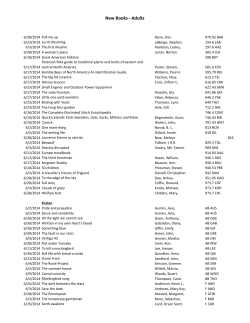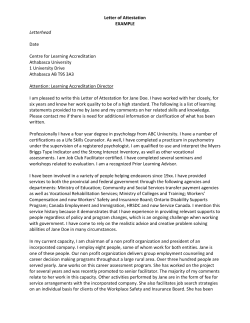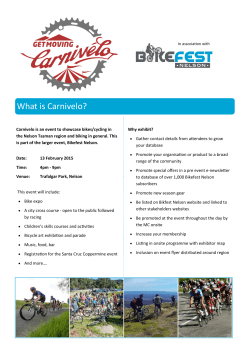
Writer SAMPLE REPORT for 1-800-872-1726
SAMPLE REPORT for Writer 19500 Bulverde Road, San Antonio, Texas 78259-3701 To find out more, call 1-800-872-1726, or visit our Web site at www.PsychCorp.com 1-800-872-1726 • www.PsychCorp.com “Wechsler Intelligence Scale for Children”, “WISC”, and “Writer” are trademarks of The Psychological Corporation. Copyright © 2003 by The Psychological Corporation. ™ WISC-IV Interpretive Report EXAMINEE: AGE: DATE OF BIRTH: EXAMINEE ID: GENDER: Jane Smith 10 years 6 months 01/01/1993 00001 Female Tests Administered: WISC–IV (07/11/2003) REPORT DATE: GRADE: ETHNICITY: EXAMINER: 07/12/2003 5 White, not Hispanic origin Jerry Jones, Psy.D. Age at Testing: 10 years 6 months SCORES SUMMARY WISC–IV SCALE SCORE Verbal Comprehension Index (VCI) Perceptual Reasoning Index (PRI) 104 102 Working Memory Index (WMI) 86 Processing Speed Index (PSI) 91 Full Scale IQ (FSIQ) 97 Reason for Referral Jane was referred for an evaluation by her psychologist, Dr. Jones, secondary to experiencing academic difficulties. Home Jane is 10 years old and currently lives with her mother and father. There is one other child living in the home with Jane. Her custodial arrangements have changed one time in the last 3 years; however, her current living arrangement has been in effect since birth. Jane comes from a highly educated family. Her mother and father both attended graduate school. Recently, there has been an event that has caused stress in her family. Specifically, the family has experienced loss of employment of a major wage earner. Language Jane speaks only English, which she has been exposed to since birth. The language spoken in Jane’s home is English. It was observed that the child’s speech was clear and intelligible and the child demonstrated English proficiency. Development According to her mother, Jane was born with no apparent complications. She reached the following milestones within the expected age ranges: sitting alone, crawling, standing alone, walking alone, speaking first words, speaking short sentences, using toilet when awake and staying dry at night. Sensory/Motor Status According to her mother, Jane’s visual screening was conducted on July 1, 2003 and revealed that she has a need for complete visual examination. Her hearing screening revealed that she has a normal auditory acuity. It was observed that she appeared to have trouble focusing visually. Copyright © 2003 by The Psychological Corporation, a Harcourt Assessment Company. All rights reserved. Printed in the United States of America. Page 1 of 9 Pre Publication Version 1.0 WISC-IV Interpretive Report Medical/Psychiatric/Neurological Status Jane has no major medical/psychiatric concerns. Her mother reports that she has no sign of neurological concerns in the past or currently. Medication/Substance Abuse According to Jane’s mother, she has taken medication in the past for a cold, an ear infection, and flu symptoms. She is currently taking medication to treat allergy symptoms. Jane has no history of substance abuse. It was observed that she did not appear under the influence of any medication or substance during testing. Educational History Her mother reports that as for pre-kindergarten, Jane attended a special services pre-school. Also, she attended a half-day kindergarten program. In addition, Jane attended the same school since initial enrollment in school. Regarding school attendance, she currently is maintaining good attendance and she had an excellent attendance record in the past. As for her conduct in school, at this time she is extremely well-behaved and she had an exemplary record in the past. Regarding academic performance, at this time she is experiencing many academic difficulties and she had many academic difficulties in the past. Most recent standardized test results show that she scored below average in Reading, Math, and Language. Behavioral Observations Jane arrived on time for the assessment and was accompanied by her mother. She appeared alert and oriented, and appeared to put her best effort into the testing process. Interpretation of WISC–IV Results Jane was administered fifteen subtests of the Wechsler Intelligence Scale for Children – Fourth Edition (WISC-IV) from which her composite scores are derived. The Full Scale IQ (FSIQ) is derived from a combination of ten subtest scores and is considered the most representative estimate of global intellectual functioning. Jane's general cognitive ability is within the Average range of intellectual functioning, as measured by the FSIQ. Her overall thinking and reasoning abilities exceed those of approximately 42% of children her age (FSIQ = 97; 95% confidence interval = 92 – 102). Her ability to think with words is comparable to her ability to reason without the use of words. Both Jane's verbal and nonverbal reasoning abilities also are in the Average range. Jane's verbal reasoning abilities as measured by the Verbal Comprehension Index are in the average range and above those of approximately 61% of her peers (VCI = 104; 95% confidence interval = 97 – 101). The Verbal Comprehension Index is designed to measure verbal reasoning and concept formation. Jane’s performance on the subtests that contribute to the VCI are all in the average range, suggesting that her abilities in this domain are similarly developed. Jane's nonverbal reasoning abilities as measured by the Perceptual Reasoning Index are in the Average range and above those of approximately 55% of her peers (PRI = 102; 95% confidence interval = 94 – 109). The Perceptual Reasoning Index is designed to measure nonverbal concept formation, visual perception and organization, simultaneous processing, visual-motor coordination, learning, and the ability to separate figure and ground in visual stimuli. Jane’s Copyright © 2003 by The Psychological Corporation, a Harcourt Assessment Company. All rights reserved. Printed in the United States of America. Page 2 of 9 Pre Publication Version 1.0 WISC-IV Interpretive Report performance on the subtests that contribute to the PRI are somewhat variable, suggesting that her abilities in this domain are less equally developed. Jane's working memory abilities as measured by the Working Memory Index are in the Low Average range but above those of only 18% of her peers (WMI = 86; 95% confidence interval = 79 – 95). Jane's abilities to sustain attention, concentrate, and exert mental control are a weakness relative to her verbal comprehension and perceptual reasoning abilities. Mental control is the ability to attend to and hold information in short-term memory while performing some operation or manipulation with it. Jane's difficulty when asked to repeat long strings of numbers backward is evidence of weak mental control. A relative weakness in mental control may make the processing of complex information more time-consuming for Jane, drain her mental energies more quickly as compared to other children her age, and perhaps result in more frequent errors on a variety of learning tasks. The academic difficutlies noticed by Mrs. Jones may be related to this weakness in mental control. This pattern is more common among children who are experiencing academic difficulties in the classroom than among those who are not. Jane performed signifcantly higher on the Arithmetic subtest (Scaled Score = 10) than on the Letter-Number Sequencing subtest (Scaled Score = 7). Both of these tasks require attention, concentration, and mental control, but the Arithmetic subtest also requires specific abilities in numerical operations and mathematics reasoning. Jane's speed of processing abilities as measured by the Processing Speed Index are in the average range and above those of approximately 27% of her peers (PSI = 91; 95% confidence interval = 83 - 101). Processing visual material quickly is an ability that Jane performs poorly as compared to her verbal reasoning ability. Processing speed is an indication of the rapidity with which Jane can mentally process simple or routine information without making errors. Performance on this task may be influenced by visual discrimination and visual-motor coordination. Because learning often involves a combination of routine information processing (such as reading) and complex information processing (such as reasoning), a relative weakness in the speed of processing routine information may make the task of comprehending novel information more timeconsuming and difficult for Jane. Thus, this relative weakness in simple visual scanning and tracking may leave her less time and mental energy for the complex task of understanding new material. The problems noticed by Mrs. Jones may be related to this weakness in processing speed. The pattern of processing speed abilities lower than verbal comprehension ability is more common among students who are experiencing academic difficulties than among those who are not. Intra-Individual Strengths and Weaknesses Jane achieved her best performance among the nonverbal reasoning tasks on the Matrix Reasoning subtest (Scaled Score = 12), and lowest score on the Block Design subtest (Scaled Score = 9). Her performance across these areas differs significantly, suggesting that these are the areas of most pronounced strength and weakness, respectively, in Jane’s profile of nonverbal reasoning abilities. The Block Design subtest required Jane to use two-color cubes to construct replicas of two-dimensional, geometric patterns. This subtest assesses ability to mentally organize visual information. More specifically, this subtest assesses her ability to analyze partwhole relationships when information is presented spatially. Performance on this task also may be influenced by visual-spatial perception and visual perception-fine motor coordination, as well Copyright © 2003 by The Psychological Corporation, a Harcourt Assessment Company. All rights reserved. Printed in the United States of America. Page 3 of 9 Pre Publication Version 1.0 WISC-IV Interpretive Report as planning ability. The Matrix Reasoning subtest requried Jane to look at an incomplete matrix and select the missing portion from five response options. This subtest measures visual information processing and abstract reasoning skills. Summary Jane is a 10-year-old child who completed the WISC–IV. She was referred by her psychologist, Dr. Jones, secondary to experiencing academic difficulties. Her general cognitive ability, as estimated by the WISC–IV, is in the Average range when compared to her peers (FSIQ = 97). Jane’s verbal abilities were in the Average range (VCI = 104), and nonverbal reasoning abilities were in the Average range (PRI = 102). Recommendations • • • Jane is encouraged to regularly and frequently review information that must be remembered. Family and teachers could review this information with her and provide positive reinforcement for improvement. Jane may benefit from “chunking” information, a strategy in which pieces of information are grouped together into larger chunks so that fewer “bits” need to be remembered. For example, the seven digits of a telephone number can be grouped into four numbers: 555-5678 becomes five, fifty-five, fifty-six, seventy-eight. Jane’s family are encouraged to support her efforts in completing homework while avoiding an overemphasis on high grades. Her family may wish to focus upon the quality of work and timely completion of assignments. Copyright © 2003 by The Psychological Corporation, a Harcourt Assessment Company. All rights reserved. Printed in the United States of America. Page 4 of 9 Pre Publication Version 1.0 WISC-IV Interpretive Report Tables and Graphs Composite Scores Summary Scale Verbal Comprehension (VCI) Perceptual Reasoning (PRI) Working Memory (WMI) Processing Speed (PSI) Full Scale (FSIQ) Sum of Scaled Scores 33 31 15 17 96 Composite Score 104 102 86 91 97 Percentile Rank 61 55 18 27 42 95% Confidence Interval 97-111 94-109 79-95 83-101 92-102 Qualitative Description Average Average Low Average Average Average Vertical bar represents the Standard Error of Measurement. Composite VCI PRI WMI Score 104 102 86 SEM 3.67 3.97 4.24 Composite PSI FSIQ Score 91 97 Copyright © 2003 by The Psychological Corporation, a Harcourt Assessment Company. All rights reserved. Printed in the United States of America. Page 5 of 9 Pre Publication Version 1.0 SEM 4.74 2.6 WISC-IV Interpretive Report Verbal Comprehension Subtest Scores Summary Raw Subtests Score Similarities 23 Vocabulary 38 Comprehension 24 (Information) 17 (Word Reasoning) 14 Scaled Score 11 11 11 10 10 Test Age Equiv. 11:6 12:2 11:6 10:6 10:6 Percentile Rank 63 63 63 50 50 Perceptual Reasoning Subtest Scores Summary Raw Subtests Score Block Design 30 Picture Concepts 17 Matrix Reasoning 24 (Picture Completion) 24 Scaled Score 9 10 12 10 Test Age Equiv. 9:10 10:2 12:10 9:10 Percentile Rank 37 50 75 50 Working Memory Subtest Scores Summary Raw Subtests Score Digit Span 13 Letter-Number Sequencing 13 (Arithmetic) 22 Scaled Score 8 7 10 Test Age Equiv. 8:2 7:10 10:2 Percentile Rank 25 16 50 Processing Speed Subtest Scores Summary Raw Subtests Score Coding 38 Symbol Search 20 (Cancellation) 64 Scaled Score 8 9 8 Test Age Equiv. 8:10 9:6 8:6 Percentile Rank 25 37 25 Copyright © 2003 by The Psychological Corporation, a Harcourt Assessment Company. All rights reserved. Printed in the United States of America. Page 6 of 9 Pre Publication Version 1.0 WISC-IV Interpretive Report Vertical bar represents the Standard Error of Measurement. Subtest Score SEM Subtest Similarities (SI) 11 1.12 Picture Completion (PCm) Vocabulary (VC) 11 0.95 Digit Span (DS) Comprehension (CO) 11 1.34 Letter-Number Sequencing (LN) Information (IN) 10 1.24 Arithmetic (AR) Word Reasoning (WR) 10 1.37 Coding (CD) Block Design (BD) 9 1.2 Symbol Search (SS) Picture Concepts (PCn) 10 1.2 Cancellation (CA) Matrix Reasoning (MR) 12 0.99 Score 10 8 7 10 8 9 8 Copyright © 2003 by The Psychological Corporation, a Harcourt Assessment Company. All rights reserved. Printed in the United States of America. Page 7 of 9 Pre Publication Version 1.0 SEM 1.16 0.99 0.99 0.9 0.99 1.34 1.2 WISC-IV Interpretive Report Composite Score Differences Scaled Score 1 104 104 104 102 102 86 Discrepancy Comparisons VCI - PRI VCI - WMI VCI - PSI PRI - WMI PRI - PSI WMI - PSI Base Rate by Overall Sample Statistical Significance (Critical Values) at the .05 level Scaled Score 2 102 86 91 86 91 91 Diff. 2 18 13 16 11 -5 Critical Value 10.6 10.99 11.75 11.38 12.12 12.46 Sig. Diff. Y/N N Y Y Y N N Diff. 1 -1 1 -2 -3 0 1 Critical Value 2.83 3.55 3.36 2.94 2.80 3.58 3.80 Sig. Diff. Y/N N N N N Y N N Base Rate 43.6% 9.9% 21% 15.1% 24.2% 42.1% Subtest Score Differences Scaled Scaled Discrepancy Comparisons Score 1 Score 2 Digit Span - Letter-Number Sequencing 8 7 Coding - Symbol Search 8 9 Similarities - Picture Concepts 11 10 Digit Span - Arithmetic 8 10 Letter-Number Sequencing - Arithmetic 7 10 Coding - Cancellation 8 8 Symbol Search - Cancellation 9 8 Statistical Significance (Critical Values) at the .05 level Differences between Subtest and Mean of Subtest Scores Subtest Mean Diff. Scaled Scaled from Subtest Score Score Mean Block Design 9 9.6 -0.60 Similarities 11 9.6 1.40 Digit Span 8 9.6 -1.60 Picture Concepts 10 9.6 0.40 Coding 8 9.6 -1.60 Vocabulary 11 9.6 1.40 Letter-Number Sequencing 7 9.6 -2.60 Matrix Reasoning 12 9.6 2.40 Comprehension 11 9.6 1.40 Symbol Search 9 9.6 -0.60 Overall: Mean = 9.6, Scatter = 5, Base Rate = 90.3% Statistical Significance (Critical Values) at the .05 level Critical Value 3.01 3.01 2.87 3.39 3.17 2.70 2.63 2.68 3.44 3.56 S/W Copyright © 2003 by The Psychological Corporation, a Harcourt Assessment Company. All rights reserved. Printed in the United States of America. Page 8 of 9 Pre Publication Version 1.0 Base Rate 39.1% 44.8% 41.5% 28.7% 17.6% 45.1% Base Rate >25% >25% >25% >25% >25% >25% 10-25% 10-25% >25% >25% WISC-IV Interpretive Report Process Summary and Discrepancy Analysis Process Score Raw Score Block Design No Time Bonus 30 Digit Span Forward 8 Digit Span Backward 5 Cancellation Random 28 Cancellation Structured 36 Process Score Longest Digit Span Forward (LDSF) Longest Digit Span Backward (LDSB) Raw Score 6 3 Process Discrepancy Comparisons Process Score Raw Score 1 LDSF - LDSB 6 Base Rate by All Ages Scaled Score 10 9 7 8 9 Base Rate 60.5% 94.5% Raw Score 2 3 Scaled Scaled Subtest/Process Score Score 1 Score 2 Block Design - Block Design No Time Bonus 9 10 Digit Span Forward - Digit Span Backward 9 7 Cancellation Random - Structured 8 9 Statistical Significance (Critical Values) at the .05 level Difference 3 Diff. -1.00 2.00 -1.00 Critical Value 3.26 3.62 4.40 Base Rate 31.4% Sig. Diff. Y/N N N N This report is valid only if signed by a qualified professional: _________________________________________________ [Examiner Signature] Copyright © 2003 by The Psychological Corporation, a Harcourt Assessment Company. All rights reserved. Printed in the United States of America. Page 9 of 9 Pre Publication Version 1.0 Base Rate 24.3% 30.4% 41.0%
© Copyright 2025










